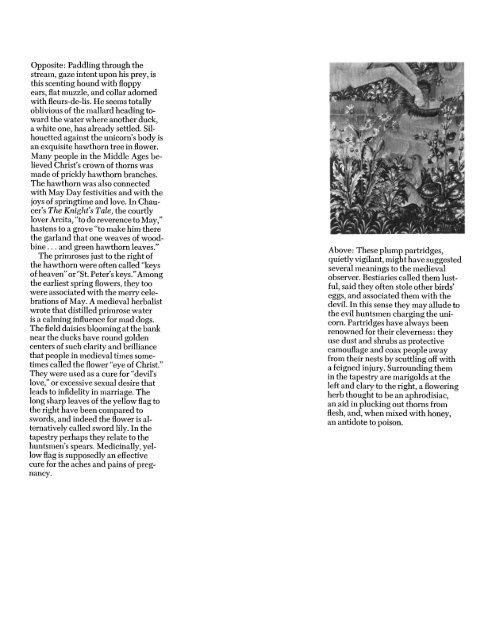The Tapestries - Metropolitan Museum of Art
The Tapestries - Metropolitan Museum of Art
The Tapestries - Metropolitan Museum of Art
Create successful ePaper yourself
Turn your PDF publications into a flip-book with our unique Google optimized e-Paper software.
Opposite: Paddling through the<br />
stream, gaze intent upon his prey, is<br />
this scenting hound with floppy<br />
ears, flat muzzle, and collar adomed<br />
with fleurs-de-lis. He seems totally<br />
oblivious <strong>of</strong> the mallard heading toward<br />
the water where another duck,<br />
a white one, has already settled. Silhouetted<br />
against the unicorn's body is<br />
an exquisite hawthorn tree in flower.<br />
Many people in the Middle Ages believed<br />
Christ's crown <strong>of</strong> thorns was<br />
made <strong>of</strong> prickly hawthom branches.<br />
<strong>The</strong> hawthorn was also connected<br />
with May Day festivities and with the<br />
joys <strong>of</strong> springtime and love. In Chaucer's<br />
<strong>The</strong> Knight's Tale, the courtly<br />
lover Arcita, "to do reverence to May,"<br />
hastens to a grove "to make him there<br />
the garland that one weaves <strong>of</strong> woodbine<br />
. . . and green hawthom leaves."<br />
<strong>The</strong> primroses just to the right <strong>of</strong><br />
the hawthom were <strong>of</strong>ten called "keys<br />
<strong>of</strong> heaven" or"St. Peter's keys."Among<br />
the earliest spring flowers, they too<br />
were associated with the merry celebrations<br />
<strong>of</strong> May. A medieval herbalist<br />
wrote that distilled primrose water<br />
is a calming influence for mad dogs.<br />
<strong>The</strong> field daisies blooming at the bank<br />
near the ducks have round golden<br />
centers <strong>of</strong> such clarity and brilliance<br />
that people in medieval times sometimes<br />
called the flower"eye <strong>of</strong> Christ."<br />
<strong>The</strong>y were used as a cure for "devil's<br />
love," or excessive sexual desire that<br />
leads to infidelity in marriage. <strong>The</strong><br />
long sharp leaves <strong>of</strong> the yellow flag to<br />
the right have been compared to<br />
swords, and indeed the flower is alternatively<br />
called sword lily. In the<br />
tapestry perhaps they relate to the<br />
huntsmen's spears. Medicinally, yellow<br />
flag is supposedly an effective<br />
cure for the aches and pains <strong>of</strong> pregnancy.<br />
Above: <strong>The</strong>se plump partridges,<br />
quietly vigilant, might have suggested<br />
several meanings to the medieval<br />
observer. Bestiaries called them lustful,<br />
said they <strong>of</strong>ten stole other birds'<br />
eggs, and associated them with the<br />
devil. In this sense they may allude to<br />
the evil huntsmen charging the unicorn.<br />
Partridges have always been<br />
renowned for their cleverness: they<br />
use dust and shrubs as protective<br />
camouflage and coax people away<br />
from their nests by scuttling <strong>of</strong>f with<br />
a feigned injury. Surrounding them<br />
in the tapestry are marigolds at the<br />
left and clary to the right, a flowering<br />
herb thought to be an aphrodisiac,<br />
an aid in plucking out thorns from<br />
flesh, and, when mixed with honey,<br />
an antidote to poison.

















